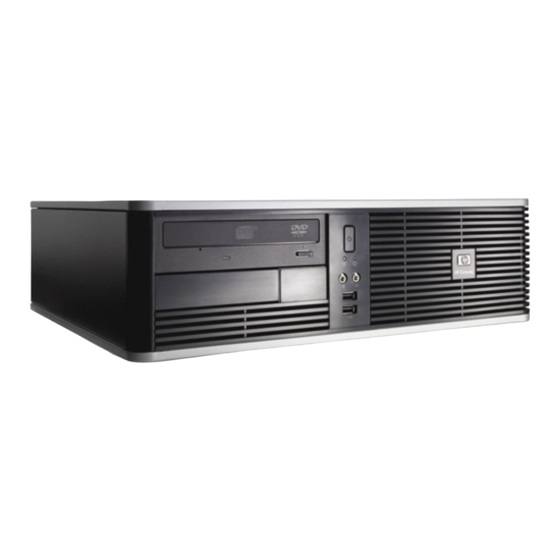
Compaq dc5800 - Microtower PC Manual
Computer setup (f10) utility
Hide thumbs
Also See for dc5800 - Microtower PC:
- Reference manual (255 pages) ,
- User manual (72 pages) ,
- Troubleshooting manual (70 pages)
Table of Contents
Advertisement
Quick Links
Advertisement
Table of Contents

Subscribe to Our Youtube Channel
Summary of Contents for Compaq dc5800 - Microtower PC
- Page 1 Computer Setup (F10) Utility Guide - dc5800 Models HP Compaq Business PCs...
- Page 2 No part of this document may be photocopied, reproduced, or translated to another language without the prior written consent of Hewlett-Packard Company. Computer Setup (F10) Utility Guide HP Compaq Business PCs First Edition (January 2008) Document Part Number: 460194-001...
-
Page 3: About This Book
About This Book This guide provides instructions on how to use Computer Setup. This tool is used to reconfigure and modify computer default settings when new hardware is installed and for maintenance purposes. WARNING! Text set off in this manner indicates that failure to follow directions could result in bodily harm or loss of life. - Page 4 About This Book ENWW...
-
Page 5: Table Of Contents
Table of contents Computer Setup (F10) Utility Computer Setup (F10) Utilities ......................1 Using Computer Setup (F10) Utilities .................. 2 Computer Setup—File ......................3 Computer Setup—Storage ....................4 Computer Setup—Security ....................6 Computer Setup—Power ..................... 9 Computer Setup—Advanced ..................... 10 Recovering the Configuration Settings .................... - Page 6 ENWW...
-
Page 7: Computer Setup (F10) Utility
Computer Setup (F10) Utility Computer Setup (F10) Utilities Use Computer Setup (F10) Utility to do the following: ● Change factory default settings. ● Set the system date and time. ● Set, view, change, or verify the system configuration, including settings for processor, graphics, memory, audio, storage, communications, and input devices. -
Page 8: Using Computer Setup (F10) Utilities
● Solve system configuration errors detected but not automatically fixed during the Power-On Self- Test (POST). ● Replicate the system setup by saving system configuration information on diskette and restoring it on one or more computers. ● Execute self-tests on a specified ATA hard drive (when supported by drive). ●... -
Page 9: Computer Setup-File
Computer Setup—File NOTE: Support for specific Computer Setup options may vary depending on the hardware configuration. Table 2 Computer Setup—File Option Description System Information Lists: ● Product name ● SKU number (some models) ● Processor type/speed/stepping ● Cache size (L1/L2) (dual core processors have this listed twice) ●... -
Page 10: Computer Setup-Storage
Computer Setup—Storage NOTE: Support for specific Computer Setup options may vary depending on the hardware configuration. Table 3 Computer Setup—Storage Option Description Device Configuration Lists all installed BIOS-controlled storage devices. When a device is selected, detailed information and options are displayed. The following options may be presented. - Page 11 Table 3 Computer Setup—Storage (continued) Allows you to specify the parameters (logical cylinders, heads, and sectors per track) used by the BIOS to translate disk I/O requests (from the operating system or an application) into terms the hard drive can accept. Logical cylinders may not exceed 1024. The number of heads may not exceed 256.
-
Page 12: Computer Setup-Security
Computer Setup—Security NOTE: Support for specific Computer Setup options may vary depending on the hardware configuration. Table 4 Computer Setup—Security Option Description Setup Password Allows you to set and enable setup (administrator) password. NOTE: If the setup password is set, it is required to change Computer Setup options, flash the ROM, and make changes to certain plug and play settings under Windows. - Page 13 Table 4 Computer Setup—Security (continued) ● Legacy diskette ● Embedded security device (some models) ● SATA0 ● SATA1 (some models) ● SATA4 (some models) ● SATA5 (some models) Network Service Boot Enables/disables the computer’s ability to boot from an operating system installed on a network server.
- Page 14 Table 4 Computer Setup—Security (continued) OS management of Embedded Security Device (some models) (enable/disable) This option allows the user to limit operating system control of the Embedded Security Device. Changing this setting requires turning the computer off and then back on. This option allows the user to limit OS control of the Embedded Security Device.
-
Page 15: Computer Setup-Power
Computer Setup—Power NOTE: Support for specific Computer Setup options may vary depending on the hardware configuration. Table 5 Computer Setup—Power Option Description ● OS Power Runtime Power Management— Enable/Disable. Allows certain operating systems to reduce Management processor voltage and frequency when the current software load does not require the full capabilities of the processor. -
Page 16: Computer Setup-Advanced
Computer Setup—Advanced NOTE: Support for specific Computer Setup options may vary depending on the hardware configuration. Table 6 Computer Setup—Advanced (for advanced users) Option Heading Power-On Options Allows you to set: ● POST mode (QuickBoot, FullBoot, or FullBoot every 1–30 days). ●... - Page 17 Table 6 Computer Setup—Advanced (for advanced users) (continued) NOTE: If you turn off power to the computer using the switch on a power strip, you will not be able to use the suspend/sleep feature or the Remote Management features. ● POST Delay (None, 5, 10 15, or 20 seconds).
-
Page 18: Recovering The Configuration Settings
Table 6 Computer Setup—Advanced (for advanced users) (continued) ● Multi-Processor (enable/disable). This option may be used to disable multi-processor support under the OS. ● Internal speaker (some models) (does not affect external speakers) ● Monitor Tracking (enable/disable). Allows BIOS to save monitor asset information. ●...














Need help?
Do you have a question about the dc5800 - Microtower PC and is the answer not in the manual?
Questions and answers